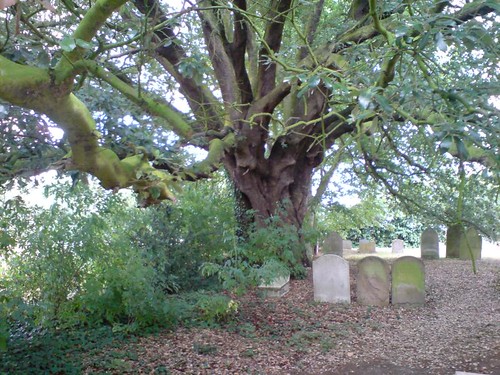My stroll through the history of Furze Hill, guided by the efforts of those that had taken the time to record the girth of some ancient trees had been enjoyable. My eyes had literally been opened to new knowledge.
It seems like a geeky thing to do, but I am all for that. So embracing my inner geek, I thought it was time to give a little back to the community that is logging the old and commendable trees of UK.
In a churchyard a few miles from Furze Hill I had a recollection of a most wonderful tree. It is a favourite tree. I saw it a few years ago and the memory has remained. Given this is as close as I am likely to get for a while, I went where memory took me.
Old tree in churchyard means only one thing in my mind, Yew Tree.
The church barely has a parish to serve now, it is at least a mile from anything significant, but it seems to have congregation enough to remain viable. There is a pond on the outskirts of it and a graveyard of some size and much used down the centuries, generations of families from pre-mass transit days. The church must be linked with the manor house nearby.
The tree itself is as high as the square tower of the church, a good deal more wondrous too look at and shades a considerable part of the churchyard.
Some gravestones have been moved and cracked by the trees continued growth. The branches are thick and twisted and in places threaten to touch the ground.
There is something otherworldly about this. Dwelling on the nutrient source for its root system is not completely comforting. Is this what prompts such strange growth? At the same time I sort of like the extended lifespan being part of a tree confers upon you.
The tree turned out not a yew, it was not one of the few species I am capable of recognising instantly. Still it would only be a matter of leaf comparisons later. I took enough pictures of the leaves to help identification. The tree was looking very healthy and vigorous, no need to remove a leaf from it when a picture will do.
Measuring the tree was made slightly more problematic because a group of hornets were busy in a pear tree 20 foot or so away. Not good, but they seemed to be minding their own business. I had seen a broken wasp nest in the ground next to the footpath earlier. The occupants of the nest were not best pleased. It felt like I was pushing my luck a bit.
My shoulder is 1.5m off the ground, a good height for measuring tree girths, I was built for the task. Too add another level of geekiness I can measure a 1m length of string to a 1cm+/- relentlessly just by arm span. Hand for 10cm measurement. fingers for 2cm. Well everyone needs a hobby :)
None of this was needed as I had prepared a 7m cord with knots at 1m intervals. The tree was a warty rascal and had a girth of 5m 30cm, maybe a little more, but this can hardly be exact science.
There was still the issue of identification. Thankfully after some feeble efforts searching the internet I gave up and asked on the Wild about Britain forum. Within half an hour I had my answer, Holm Oak. 
5.3m girth put it in a category worthy of note so I placed it on the ancient tree website where it awaits verification.
It was a nice feeling to put this tree on the map, give it a bit of recognition the person that planted it could never have imagined possible. It is not much but it is a bit.
The Holm Oak sitting on the Woodland Trusts website, recorded, awaiting verification (I wonder if that will happen)


No comments:
Post a Comment